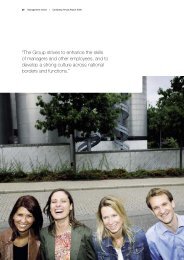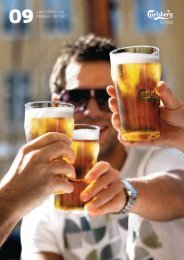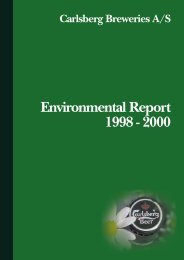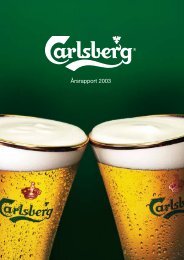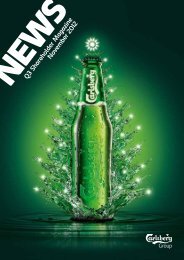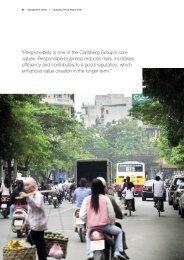116770 Project Obelix Pt1.qxp - Carlsberg Group
116770 Project Obelix Pt1.qxp - Carlsberg Group
116770 Project Obelix Pt1.qxp - Carlsberg Group
Create successful ePaper yourself
Turn your PDF publications into a flip-book with our unique Google optimized e-Paper software.
<strong>Carlsberg</strong> Breweries <strong>Group</strong>trademark is determined to be indefinite. In the opinion of management, there is only a minimal risk of thecurrent situation in the markets reducing the useful life of trademarks, primarily due to the respective marketshare in each market and the current and planned marketing efforts which are helping to maintain andincrease the value of these trademarks.Measurement is based on expected future cash flows for the trademarks on the basis of key assumptionsabout expected useful life and royalty rate and a theoretically calculated tax effect. A post-tax discount rate isused which reflects the risk-free interest rate with the addition of specific and estimated future risksassociated with the particular trademark.Management performs an annual assessment of whether the current market situation in the relevant markethas reduced the value or useful lives of trademarks. When there is an indication of a reduction in the value oruseful life, the trademark is written down or amortisation is increased in line with the trademark’s shorteruseful life.Customer agreements and portfoliosIn business combinations, the value of acquired customer agreements and customer portfolios is assessedbased on the local market and trading conditions. The relationship between trademarks and customers iscarefully considered so that trademarks and customer agreements are not both recognised on the basis ofthe same underlying cash flows. In the case of breweries in Asia, there is a particularly close relationshipbetween trademark and sales, as geographical location and local trading are significant. Therefore, normallyno separate value for customer agreements will be recognised in these cases, as customer relations areclosely associated with the value of the acquired trademarks.Measurement is based on expected future cash flows for the customer agreements on the basis of keyassumptions about sales growth, operating margin, customer retention rate and theoretically calculated taxand contributions to other assets. A post-tax discount rate is used which reflects the risk-free interest ratewith the addition of specific and future risks associated with the customer agreements.Impairment testingIn performing the annual impairment test of goodwill, an assessment is made as to whether the individualunits of the entity (cash-generating units) to which goodwill relates will be able to generate sufficient positivenet cash flows in the future to support the value of goodwill and other net assets of the entity.The estimates of future net free cash flows (value in use) are based on budgets and business plans for thenext three years and projections for subsequent years. Key parameters are revenue growth, operatingmargin, future capital expenditure and growth expectations beyond the next three years. Budgets andbusiness plans for the next three years are based on concrete commercial initiatives, and the risksassociated with the key parameters are assessed and incorporated in expected future free cash flows.<strong>Project</strong>ions beyond the next three years are based on general expectations and risks. Budgets and businessplans do not incorporate the effect of future restructurings and non-contracted capacity increases.Pre-tax discount rates which reflect the risk-free interest rate with the addition of specific risks in eachparticular geographical segment are used to calculate recoverable amounts. The cash flows used alreadyincorporate the effect of relevant future risks, and accordingly these risks are not incorporated in the discountrates used.For a description of impairment testing for intangible assets, see note 16.Estimates of future earnings from trademarks with an indefinite useful life are made using the same model asis used to measure trademarks in business combinations, cf. above. Assessment of indications ofimpairment of trademarks with indefinite useful lives is made at <strong>Group</strong> level, as royalty income is earnedglobally across segments.Management performs an annual test for indications of impairment of trademarks with a finite useful life otherthan the decrease in value reflected by amortisation. Impairment tests are conducted in the same way as fortrademarks with an indefinite useful life when there is an indication that the assets may be impaired.F-98


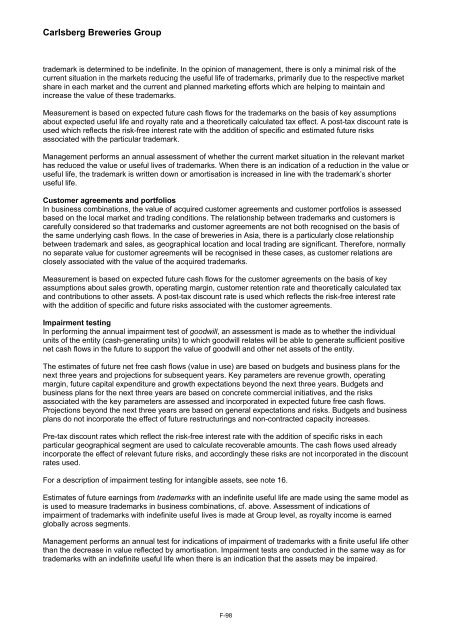
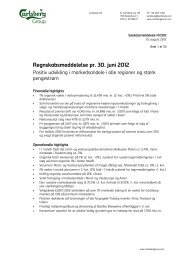

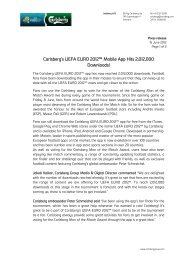
![[Name and Address] - Carlsberg Group](https://img.yumpu.com/49766377/1/184x260/name-and-address-carlsberg-group.jpg?quality=85)

![[Name and Address] - Carlsberg Group](https://img.yumpu.com/49015962/1/184x260/name-and-address-carlsberg-group.jpg?quality=85)
